Today, Hermes ties are probably the most counterfeited ties in the world and unless you get it from an Hermes store, their website, or a trusted source, chances are you end up with a fake.
Generally, Hermes ties are very detail-oriented and we’ll help you identify those details because the fakers usually don’t pay much attention to those because it would cut into your profit margin and after all, they’re just out there to make a quick buck.
We don’t just discuss the famous animal twill silk printed ties but also all other printed ties including horse ties, as well as the printed scarf ties. We talk about the heavy twill or loured silk ties from Hermes, as well as the jacquard woven ones. On top of that, we’ll show you how Hermes ties changed throughout the decades so you can always easily spot the genuine product and leave behind the fake. Of course, we also point you in the right direction where you can find genuine used Hermes ties.

How Do You Distinguish A Fake From A Genuine Hermes Tie?
It all starts with the Hermes box. The Hermes ties always come in the signature orange box never in a plastic bag. If you get the box, inspect it meticulously. First of all, it has the signature Hermes orange that fakers often get wrong. The logo in the box is not super huge and measures just about 2.3 centimeters or just under an inch from the H to the S. Also, look at the font itself, the logo, as well as anything below it because fakers oftentimes get that wrong. Note the spokes on the wheels, there are many spokes in there which is, in fact, different from the spokes you can see on the labels.
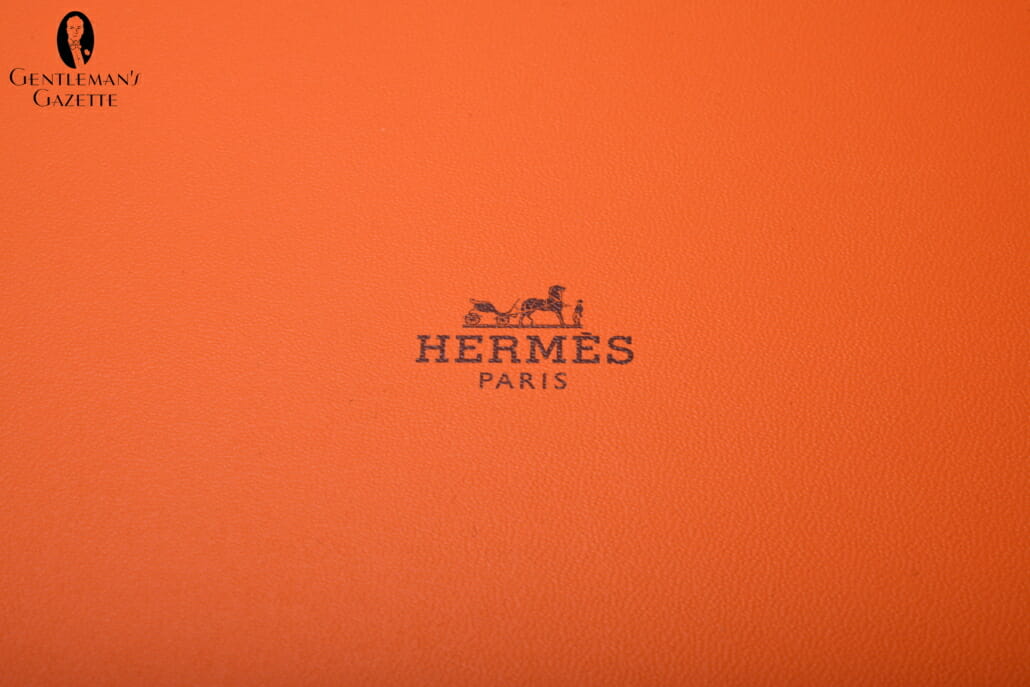
Next, look at the top edge of the box. It should be Hermes brown and not black. Usually, fake boxes use black because they don’t pay that much attention to detail and also the edge is not printed as nicely all the way around the edge. A genuine Hermes box, everything is very neat and proper. On top of that, the Hermes box has somewhat of a medium shine it’s neither matte nor glossy. And if you look at it in the light, it has somewhat of a texture that resembles leather.
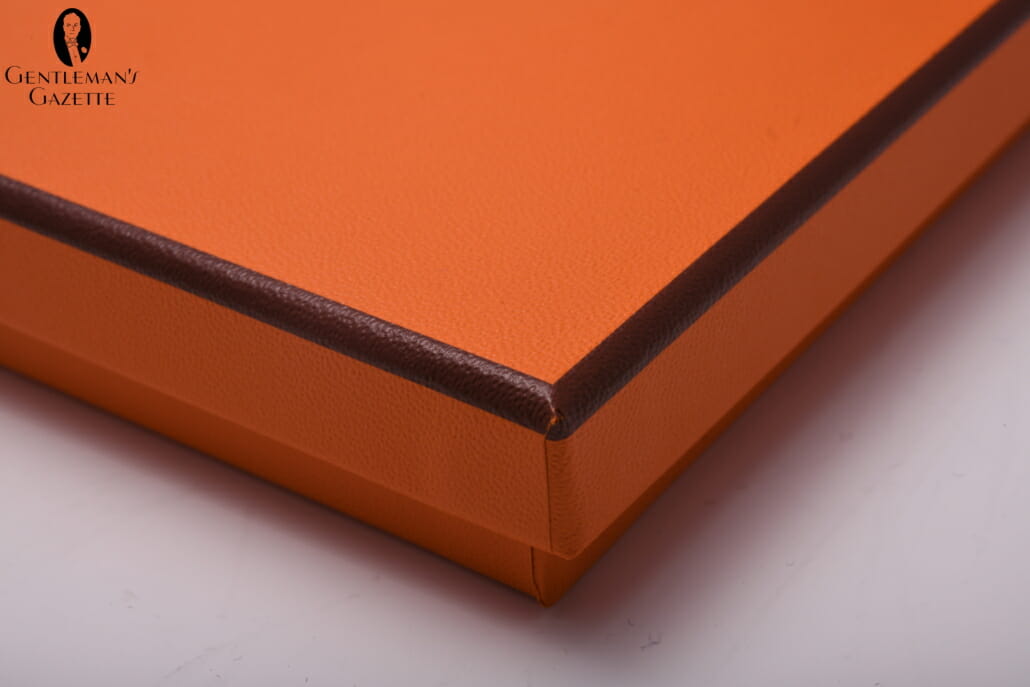
Inside of the Hermes box, you’ll find the tie wrapped in white tissue paper. Genuine Hermes ties come in solid white tissue paper. Nothing embossed with an H which is something you typically find with fake products. Also if the tissue paper comes in a different color, you know it’s a fake. If you buy more ties, you can see how consistent Hermes is. It’s always folded in the same spot. Once you remove the tissue paper, you see that the inside of the box is plain white. Fakes are often off-white or sometimes black. Not so the Hermes ones. Also look at the edges of the orange paper on the inside. They cover the walls but not the bottom part and everything is very neat.

What About Used Hermes Ties?
Now if you buy a used Hermes tie, it likely won’t come in a box so let’s take a look at the ties and what you have to pay attention to. It’s important to keep in mind that different Hermes ties such as the regular silk twill print or the heavy silk twill print, the scarf ties, or the woven ties, can all have different hallmarks. And first, we take a closer look at the famous printed ties. The ones with the animal motifs or the ones with the horse motifs or equestrian motifs that are so well known around the globe.

1. Examine The Silk
Hermes silk printed ties are always 100% silk, never polyester or any blend. Also, Hermes prints all of the regular weight silk ties on the same kind of twill so it’s always the same. In this tie department, Hermes is very integrated meaning they control everything from the raw silk to the finished product and so they have a very high amount of consistency.

When you touch the silk and go with your fingers, you hear a certain sound. It’s not a soft silk, it’s also not a super crisp silk, and it’s never shiny. It’s sophisticated and more matte. Honestly, it’s hard to describe in words and something you have to feel to really be able to judge it. That being said, if you can find a label that says anything other than 100% silk or soie which is the French term for silk, it is a fake.

2. Observe The Direction Of The Twill
On the front side of the tie on the wider blade, take a closer look at the twill pattern. It should always go from 11 to 5 o’clock. If it goes in any other direction, it’s a fake. Now if the twill direction is correct on the front, turn the tie around and look at the tie tipping. Here the twill direction should be from 2 to 8 o’clock. If you have a hard time seeing it with your eye, maybe use a magnifying glass and it should become very clear what direction the twill is in. On printed heavy silk ties or loured silk ties, the twill pattern in the front goes from 9 to 4 o’clock and the tip liner goes from 1 to 7 o’clock.

3. Take A Closer Look At The Tip Lining Color
Genuine Hermes ties usually have a color of the lining that matches the background color exactly. Fake Hermes ties often get that wrong and they have a solid black lining with H patterns on it. However, that’s a lining Hermes doesn’t in fact use but they only use it for woven ties and not even all of them. That being said, Hermes ties that were made before 1970 often have a solid white tip lining so if you see that don’t be concerned and check for the other hallmarks of a vintage Hermes tie which we’ll discuss later.

4. Inspect The Tie Bar Tacks
Four, take a close look at the tie bar tacks. These are these little sewings on either end of the fold that keep the tie from unfolding. For printed Hermes twill ties, these little tie tacks are usually in a color very close to the background color of the silk. On the other hand, fake Hermes ties usually use just a black color and their tacks are also much thicker. The Hermes tack is a little thicker than the thread but it’s overall still very fine, neat and elegant.
If there’s no bar tack in existence, chances are you have a fake. Unless of course, it’s a vintage tie where they have come loose but in that case, the whole tie should be able to fold open and you’ll have to repair it before you can wear it.

5. Look At The Dovetail Fold
By that I mean you turn the tie around, you look at the front plate and open the folds in the back. Look underneath of it and you will see a dovetail fold that is a hallmark of all Hermes ties. Typically with fakes, they don’t go to that much detail because most people never look underneath the fold and so there isn’t an extra fold. Just like the twill direction, this is a very good way to identify a genuine Hermes tie.
Also while you look at the backside of the tie, look at the folds. On a genuine Hermes tie, the left part is always folded over the right. If it’s right over left, it’s definitely a fake. Next up, look at the backside of the tip on the wider blade, the right side always overlaps the left. That being said, the workmanship is so good that it’s harder to determine with your bare eye. Simply go over with the tip of your finger and you can feel whether the right side is over the left or whether it’s the other way around.

6. Find The Slip Stitch
All Hermes ties are hand sewn with a thread that is 177 centimeters long, that’s just shy of 67 inches. Since all Hermes ties are hand sewn in a flexible way, you can gently pull on the fold and see whether there’s some slight irregularities in the stitching and also the tie is flexible. If you see dense machine stitching, it’s definitely not a genuine product.
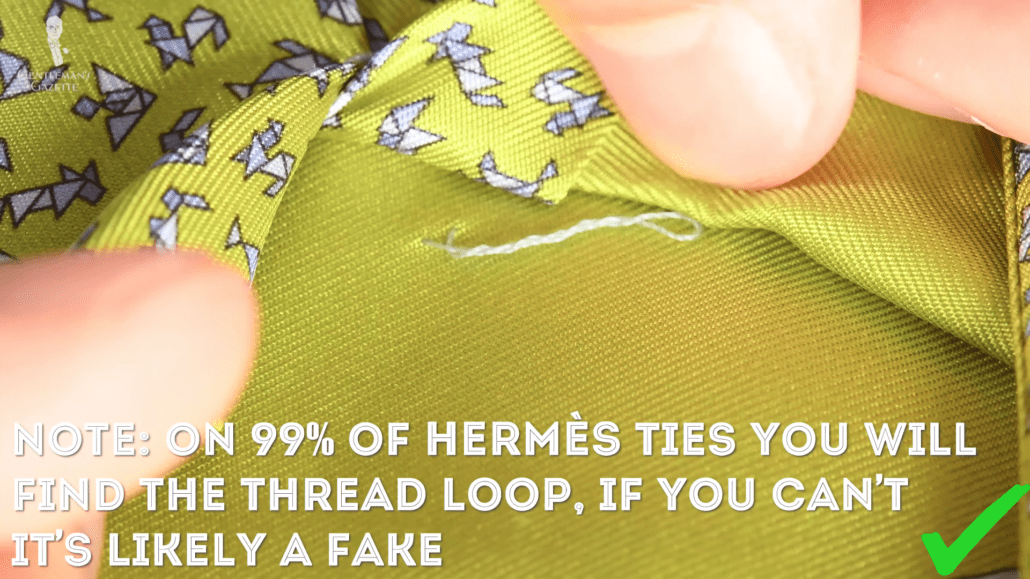
7. Find The Loop Thread
Because ties can stretch and they are made out of different layers, you need a thread that has a reserve and that reserve in Hermes ties is in the loop. Generally, all Hermes ties have the loop on the backside of the wider end of the tie. Simply fold up the top layers and try to find that little loop. On new ties, it’s generally always there; on used ties, it may not be there anymore if they’ve been stretched out and the reserve has been consumed and is now in a part where it’s not easily visible anymore.

8. Evaluate The Hermes Logo On The Slimmer Blade
On regular silk twill ties, you will always find this Hermes stamp on the front side of the slim blade. On a tie, it should say Hermes Paris all in caps and have a copyright symbol. The copyright symbol first appeared in the 1970s. Hermes ties that are older than that won’t have it so don’t be afraid if you don’t find the c, it can still be a genuine Hermes tie. Always check to see that the stamp was printed on at the tie and not sewn on or glued on because those would be hallmarks of a fake.
As I mentioned before, Hermes pays great attention to details so if the stamp is off-center or turned a little bit I would be cautious because it could be a fake. Moreover, take a closer look at the spokes in the wheel. You only see five spokes not more and not less.

9. Observe The Pattern Mark
All printed Hermes ties in twill have a pattern mark to identify the designer and the design number. It’s rectangular and it aligns with the edge fold of the tie. The top line should read made in France, all in caps, Sans Serif. The middle line should have a pattern number followed by the initials of the Artist. Those are in a serif font. Up until the early 70s, the pattern mark only had two lines. So if your stamp didn’t have the copyright symbol, your pattern mark should only have two lines. Thereafter, Hermes added a third line to a pattern mark which reads 100% soie which means silk in French. The soie should be all caps again and San Serif just like the first line.
Fakers usually don’t get that right and they have the font all either in Serif or San Serif and that’s a good way to identify a fake. Of course for this video, we didn’t just rely on existing Hermes ties we had but we also bought eight new ones from the Hermes.com website. When I unpacked those new ties, I saw that the pattern mark on the printed silk twill ties now read silk 100% soie. I’m not quite certain when exactly they made that change but it must have been recently because older ties from the mid-2000s don’t have that added silk word yet. Again, these ties came directly from Hermes and are a genuine product.
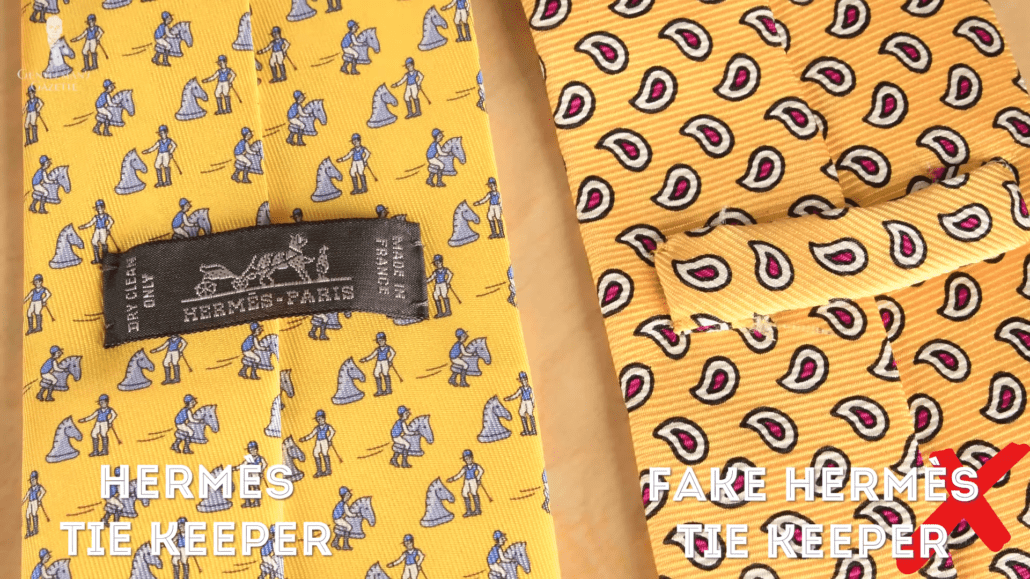
10. Notice The Tie Keeper
By that, I mean the little woven label in the back of Hermes ties that you can use to stick the slimmer and the tie through. Unlike many other ties including the ones from Fort Belvedere, the keeper loop in Hermes is not made out of the tie silk but it’s a simple woven label that is much slimmer. It is attached in four spots and fakes often have that label in addition to a tie keeper loop made out of the fabric. If you ever see an Hermes tie with a tie keeper made out of the same fabric as the tie, it is a fake.
Also if the tie keeper is printed, it is likewise a fake because all Hermes ones are woven. Up until the 1970s, Hermes had a woven keeper loop that had either a burgundy, a white, a blue or a black background color with a white Hermes H. Ever since the 80s, printed Hermes silk ties would usually have dry clean only on the left followed by a carriage and 100% silk on the right. The background colors could have been in black, navy or red with a white font or white with a dark font. Interestingly, if you count the spokes in the wheel you’ll get the number six, whereas the printed stamp on tie has five spokes. That’s also a good way to figure out if there’s a fake because fakers usually don’t pay attention to those small details.
Surprisingly, the printed silk Hermes ties from the 2018 collection did not just have a different pattern mark but they also had a different tie keeper. It now says dry clean only on the left, made in France on the right. It has the horse carriage as well as the words Hermes Paris woven into the underneath of it. This is typically a label that was only used on scarf ties on heavy twill, loured silk ties, as well as woven ties but not on the traditional weight printed silk twill ties.
11. Analyze The Dimensions
Modern Hermes ties are usually 150 centimeters long which is about 59 inches. There are a very few tall ties from Hermes, those are 160 centimeters long about 63 inches. I say they’re about that long because Hermes ties are cut on the bias and if you pull them, they can sometimes be a little longer by a centimeter or half an inch. In terms of width, most Hermes ties today are 8 centimeters wide or 3.15 inches. You can also find a few which are 7 centimeters wide or 2.76 inches.
However, in the 1980s, Hermes ties were typically three and a quarter inches wide. By the 90s, they were usually three and a half inches wide but you can also find Hermes ties that are almost 4 inches wide. That being said, looking at the dimensions won’t help you that much to identify a real tie from a fake one. Ultimately, what width you choose is up to your personal style. 8 or 9 centimeters are more timeless, 7 is quite slim and will likely go out of fashion again in a few years.
Personally, I think in 9 centimeters or 3 and a half inches are the best most classic and timeless tie width and because of that, Fort Belvedere offers all of their ties in this kind of width. Hermes ones, on the other hand, are really difficult to find new in a 9-centimeter width. You always have to go vintage.

12. Check Out The Weight
A regular silk twill tie from Hermes will weigh in between 44 and 47 grams. That’s around 1.6 ounces depending on the tie. Silk is a natural material and as suc,h there is slight weight differences. Tall ties from Hermes usually weigh in around 49 grams or 1.7 ounces. The Hermes loured ties weigh in at 65 grams or 2.3 ounces. So you can see that’s almost an increase in weight of 50% and you can feel it when you touch the silk, it’s much thicker than the regular printed Hermes silk ties.
Woven Hermes ties can vary much more greatly in weight depending on the specific weave and the colors incorporated because when you weave and you have more colors, the tie will be heavier than if you just have one color or two colors.

13. Look For The White Tag Fastened Around The Label
If you take it off you can put it back on and so if the tie is truly new, it should always have that label. The label has the Hermes logo on one side and a barcode on the other, as well as some descriptions as to what the tie is.

It seems like Hermes has been a little more playful with their designers in recent years. That’s best exemplified by looking at different stamps. For example, on the origami tie I’m wearing, instead of the horse carriage in the stamp they use the same origami motif on the tie. Likewise, if you look at this tie which consists of toast bread slices they added a toaster to the back of the stamp. Same goes with this tie that consists out of fountain pen nibs, you can see a fountain pen in the back.
To my knowledge, all of these details are more recent innovations that you likely won’t find on older ties. But if you do find them chances are it’s a genuine product because fakers wouldn’t go to those lengths and add those little details.

14. Note The Woven Hermes Logo On The Tip Liner
Now there’s one detail in Hermes tie that always shows you it’s a fake and that’s when the tip liner has a woven Hermes logo or any kind of printed Hermes logo on the tip liner. A genuine Hermes tie never has that and if it does, it’s a fake.
Now, these are a lot of hallmarks, I know, but if you analyze all of them your chances of finding a genuine Hermes tie are extremely high.
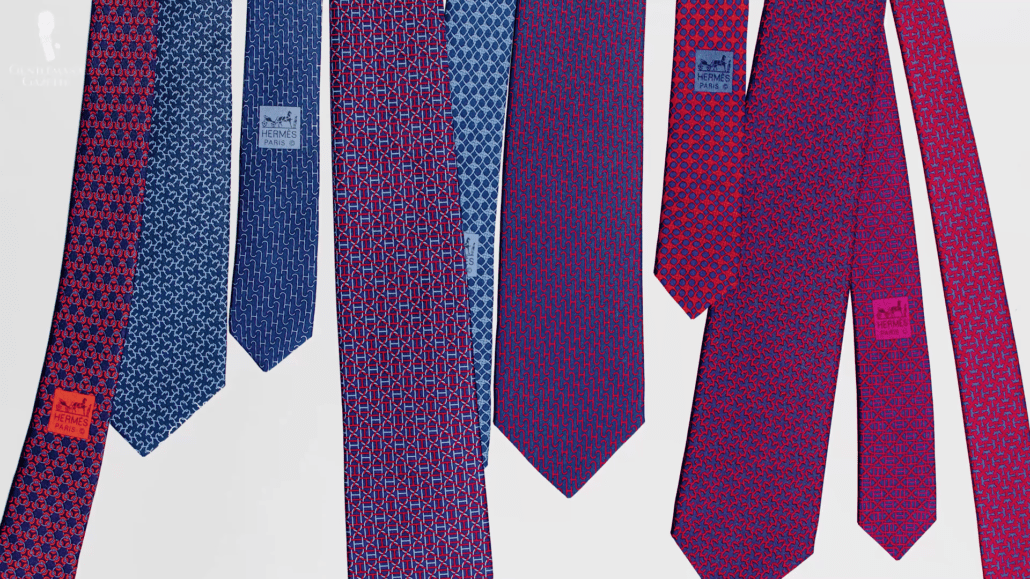
CONCLUSION
Using the hallmarks we outlined, you will increase your chances dramatically to get a genuine Hermes tie even if you buy it vintage or used. That being said, the safest way to get a genuine Hermes product is to buy directly from their website or from one of their stores.
Another option would be to buy from trusted Hermes tie sellers on eBay. Of course, if you buy there the prices are much higher for used ties and sometimes they’re very close to the retail price. The advantage is that you can find patterns there that are no longer sold at the store or online.
Sometimes you can even find ties at flea markets, Etsy or at estate sales, but usually, people know that Hermes ties are worth quite a bit and sometimes they charge a hundred and twenty dollars which is about two thirds of the retail price in the US.
Outfit Rundown

I’m wearing a classic business outfit that you would see worn by an investment banker or a typical person who has printed Hermes ties. My tie of course is a Hermes one. It’s from the 2018 collection. It has a green background and blue origami birds on it. I’m combining it with a pocket square that has tones of blue, green, and red that pick up the color of the tie and the shirt and tie everything well together. My suit is a classic Navy single-breasted 2-button business suit with pleated pants that sit high on my waist. I’m wearing them with a pair of shadow striped socks in navy blue and blue that work well with the pants but add a little bit of contrast to my black double monk strap shoes. The shirt has a very faint stripe in pale yellow and pale blue. It has double cuffs and I wear them with gold cufflinks in a monkey fist knot style which is very classic and timeless. Other than my wedding band, I’m wearing a pinky ring with a green tourmaline stone that picks up the green color in my pocket square and my tie.






Excellent report!
One last item: the brightness. It emerges as an immanence of the fabric, in any of its colors and patterns; it is a subtle permanent brightness far from “catching the eye” it manages to lose sight of the prints without being able to distinguish the continuous attractiveness of the tie. Real pieces of art.
Whoa … 177 meters? Are you sure about that? That’s about 193 yards …
cm of course
Great summary! I like you summary and only have one addition: I have also a few of the scarf ties and I have bought them as a matching set with the scarf fort my wife. That usually stands out.
Even though I don’t like Hermes ties I found this article fascinating. Great work!
Thank you!
I can imagine someone or a knockoff business making phony Polo Ralph Lauren ties or “Polo dry goods.” But why in the world would someone or a knock off company want to make a “fake Hermes tie?” To me, that’s a waste of time. In my mind, “Hermes” doesn’t stand out like “Polo Ralph Lauren,” “Givenchy,” or Brooks Brothers.
Brilliant and informative! We recently purchased 100 Hermès ties to sell. After reading this I bought with confidence. Thank you so much!